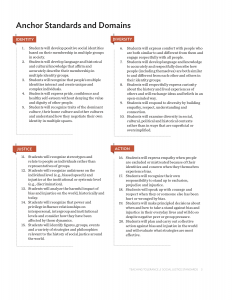Learning for Justice seeks to be a catalyst for racial justice working in partnership with communities to dismantle white supremacy, strengthen intersectional movements and advance the human rights of all people. Their digital educational resources—articles, guides, lessons, films, webinars, frameworks and more—help foster shared learning and reflection for educators to create an educational space where students can harness collective power and take action on issues about social justice. Learning for Justice encourages children and young people to challenge prejudice and learn how to be agents of change in their own lives. This week in the mentoring circle, we follow a road map guided by social justice standards for anti-bias education using digital resources that support our learning for justice.
Learning for Justice provides digital resources to educators who want to teach social justice to create civil practices and an inclusive school community, where children are respected, valued and welcome participants. From film kits and lesson plans to the building blocks of a customized Learning Plan—texts, student tasks and teaching strategies—their resources will help you bring relevance, rigour and social-emotional learning into your classroom. Their program follows a framework for anti-bias education that emphasizes on social justice standards to bolster a celebration of identity and diversity with attention to questions of justice and strategies for student action and collective action. For example, take a look at their intersectionality student-friendly video!
The Social Justice Standards are a road map for anti-bias education at every stage of K–12 instruction. Comprised of anchor standards and age-appropriate learning outcomes, the standards provide a common language and organizational structure educators can use to guide curriculum development and make schools more just and equitable. Divided into four domains—identity, diversity, justice and action (IDJA)—the standards recognize that, in today’s diverse classrooms, students need knowledge and skills related to both prejudice reduction and collective action. Together, these domains represent a continuum of engagement in anti-bias, multicultural and social justice education. Get to know the Social Justice Standards—Identity, Diversity, Justice and Action—with the following resource.  Learning for Justice partnered with the documentary A Place in the Middle to help students see the value of inclusion. Kumu Hina Wong-Kalu, an extraordinary Native Hawaiian who is both a proud and confident māhū (transgender woman), and an honoured and respected kumu (teacher, cultural practitioner, and community leader) created a “place in the middle” where every student at her small Honolulu charter school felt welcome, included and ready to learn to the best of their ability. Learning for Justice brings Hina’s teaching to K-12 schools with a youth-friendly, short version of the film. The following video clips can be used to help students to appreciate the value of inclusion, the strengths they inherit from their cultural heritage and their own power to create a school climate of honour and respect.
Learning for Justice partnered with the documentary A Place in the Middle to help students see the value of inclusion. Kumu Hina Wong-Kalu, an extraordinary Native Hawaiian who is both a proud and confident māhū (transgender woman), and an honoured and respected kumu (teacher, cultural practitioner, and community leader) created a “place in the middle” where every student at her small Honolulu charter school felt welcome, included and ready to learn to the best of their ability. Learning for Justice brings Hina’s teaching to K-12 schools with a youth-friendly, short version of the film. The following video clips can be used to help students to appreciate the value of inclusion, the strengths they inherit from their cultural heritage and their own power to create a school climate of honour and respect.
A lesson from Learning for Justice that I personally recommend is Why Do We (Still) Celebrate Columbus Day? In this lesson, students address misconceptions they likely have about Christopher Columbus and the colonization of what is now America. Students watch the video below from VOX to dispel some of the myths associated with Columbus and gain a better understanding of how Columbus Day became a national holiday. The Learning for Justice lesson plan also includes interviews with Indigenous youth and identifies the reasons that celebrating Indigenous Peoples’ Day instead of Columbus Day matters to them. This lesson is meant to ask students what changes they would like to see, based on what they’ve learned from Indigenous activists and reflect on what they could do to support the advocacy of Native communities.